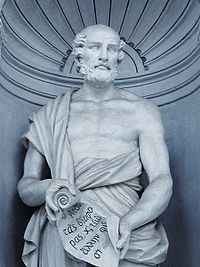 Theophrastus (/ˌθiːəˈfræstəs/; Greek: Θεόφραστος Theόphrastos; c. 371 – c. 287 BC[1]), a Greek native of Eresos in Lesbos,[2] was the successor to Aristotle in the Peripatetic school. He came to Athens at a young age and initially studied in Plato's school. After Plato's death, he attached himself to Aristotle who took to Theophrastus his writings. When Aristotle fled Athens, Theophrastus took over as at the Lyceum.[2]Theophrastus presided over the Peripatetic school for thirty-six years, during which time the school flourished greatly. He is often considered the "father of botany" for his works on plants. After his death, the Athenians honoured him with a public funeral. His successor as head of the school was Strato of Lampsacus.
Theophrastus (/ˌθiːəˈfræstəs/; Greek: Θεόφραστος Theόphrastos; c. 371 – c. 287 BC[1]), a Greek native of Eresos in Lesbos,[2] was the successor to Aristotle in the Peripatetic school. He came to Athens at a young age and initially studied in Plato's school. After Plato's death, he attached himself to Aristotle who took to Theophrastus his writings. When Aristotle fled Athens, Theophrastus took over as at the Lyceum.[2]Theophrastus presided over the Peripatetic school for thirty-six years, during which time the school flourished greatly. He is often considered the "father of botany" for his works on plants. After his death, the Athenians honoured him with a public funeral. His successor as head of the school was Strato of Lampsacus.
The interests of Theophrastus were wide ranging, extending from biology and physics to ethics and metaphysics. His two surviving botanical works, Enquiry into Plants (Historia Plantarum) and On the Causes of Plants, were an important influence on Renaissance science. There are also surviving works On Moral Characters, On Sensation, On Stones, and fragments on Physics and Metaphysics. In philosophy, he studied grammar and language and continued Aristotle's work on logic. He also regarded space as the mere arrangement and position of bodies, time as an accident of motion, and motion as a necessary consequence of all activity.[citation needed] In ethics, he regarded happiness as depending on external influences as well as on virtue.
-----------------------------------------------------------------------------------------------------
Theophrastus's Enquiry into Plants or Historia Plantarum (Greek: Περὶ φυτῶν ἱστορία, Peri phyton historia) was, along with his mentor Aristotle's History of Animals, Pliny the Elder's Natural History and Dioscorides's De Materia Medica, one of the most important books of natural history written in ancient times, and like them it was influential in the Renaissance. Theophrastus looks at plant structure, reproduction and growth; the varieties of plant around the world; wood; wild and cultivated plants; and their uses. Book 9 in particular, on the medicinal uses of plants, is one of the first herbals, describing juices, gums and resins extracted from plants, and how to gather them.
Historia Plantarum was written some time between c. 350 BC and c. 287 BC in ten volumes, of which nine survive. In the book, Theophrastus described plants by their uses, and attempted a biological classification based on how plants reproduced, a first in the history of botany. He continually revised the manuscript, and it remained in an unfinished state on his death. The condensed style of the text, with its many lists of examples, indicate that Theophrastus used the manuscript as the working notes for lectures to his students, rather than intending it to be read as a book.
Historia Plantarum was first translated into Latin by Theodore Gaza; the translation was published in 1483. Johannes Bodaeus published a frequently cited folio edition in Amsterdam in 1644, complete with commentaries and woodcut illustrations. The first English translation was made by Sir Arthur Hort and published in 1916.
No comments:
Post a Comment